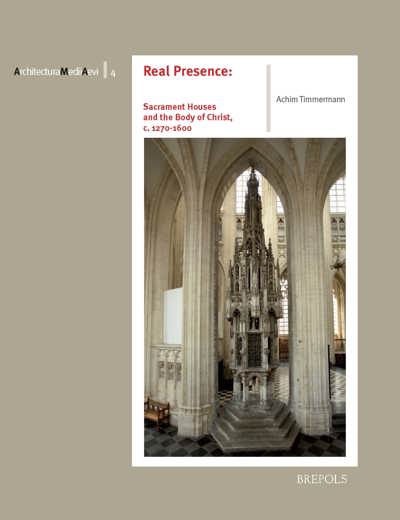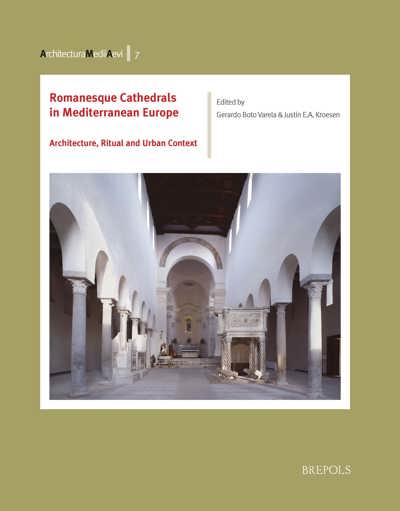
Romanesque Cathedrals in Mediterranean Europe
Architecture, Ritual and Urban Context
Gerardo Boto Varela, Justin E.A. Kroesen (eds)
- Pages: vi + 332 p.
- Size:216 x 280 mm
- Illustrations:76 b/w, 26 col.
- Language(s):English, French
- Publication Year:2016
- € 115,00 EXCL. VAT RETAIL PRICE
- ISBN: 978-2-503-55250-7
- Paperback
- Available
- € 115,00 EXCL. VAT RETAIL PRICE
- ISBN: 978-2-503-55281-1
- E-book
- Available
This volume explores the architecture and layout of Romanesque cathedrals in Europe, especially around the Mediterranean, paying special attention to liturgical ritual, church furnishings, iconography, and urban context.
« Les différents articles proposés ici, qui portent presque tous sur les cathédrales romanes du monde méditerranéen, offrent incontestablement une riche matière à réflexion qu’il est bon d’avoir présente à l’esprit pour aborder les édifies en général – également les églises abbatiales et collégiales, voire même certaines grandes églises paroissiales – et bien sûr aussi, en raison du poids du passé, les cathédrales reconstruites à l’époque gothique. » (Denise Borlée, dans Francia-Recensio, 3, 2017)
“This collection of essays is an excellent resource for anyone seeking to understand the variety of new approaches to the Romanesque cathedral (…)” (Gillian Elliott, in College Art Association Reviews, 193, 2017)
“The volume is nicely produced, generously illustrated with photos, plans and diagrams of the cathedral buildings, and the editing and translations have been done well.” (Aleksandra Macclain, in Medieval Archaeology, 61/2, 2017)
Gerardo Boto Varela is professor of the History of Medieval Art and Architecture at the University of Girona, Spain.
Justin E.A. Kroesen is associate professor of cultural history at the University of Bergen, Norway, specializing in the Material Culture of Christianity.
The architecture, interior settings and urban environment of Romanesque cathedrals around the Mediterranean offer unique insights into religion and culture in southern Europe during the 10th-13th centuries. In this period, cultural and artistic interchange around the Mediterranean gave rise to the first truly European art period in Medieval Western Europe, commonly referred to as ‘Romanesque’. A crucial aspect of this integrative process was the mobility of artists, architects and patrons, as well as the capacity to adopt new formulas and integrate them into existing patterns. Some particularly creative centers exported successful models, while others became genuine melting pots. All this took shape over the substrate of Roman Antiquity, which remained in high esteem and was frequently reused.
In these studies, Romanesque cathedrals are employed as a lens with which to analyze the complexity and dynamics of the cultural landscape of southern and central Europe from the tenth to the twelfth centuries. The architecture of every cathedral is the result of a long and complicated process of morphogenesis, defined by spatial conditions and the availability of building materials. Their interior arrangements and imagery largely reflected ritual practice and the desire to express local identities. The various contributions to this volume discuss the architecture, interior, and urban setting of Romanesque cathedrals and analyze the factors which helped to shape them. In so doing, the focus is both on the influence of patrons and on more bottom-up factors, including community practices.
Gerardo Boto Varela & Justin Kroesen, Romanesque Cathedrals in Mediterranean Europe: Balance and Perspectives
Shaping Cathedrals in the Pre-Romanesque Era
Beat Brenk, The Cathedrals of Early Medieval Italy: The Impact of the Cult of the Saints and the Liturgy on Italian Cathedrals from 300 to 1200
Jean-Pierre Caillet, French Cathedrals around the Year 1000: Forms and Functions, Antecedents, and Future
Building Romanesque Cathedrals on Older Substrates
Matthias Untermann, Between ‘Church Families’ and Monumental Architecture: German Eleventh-Century Cathedrals and Mediterranean Traditions
Mauro Cortelazzo & Renato Perinetti, Aosta Cathedral from Bishop Anselm’s Project to the Romanesque Church, 998‒1200
Gerardo Boto Varela, Inter primas Hispaniarum urbes, Tarraconensis sedis insignissima: Morphogenesis and Spatial Organisation of Tarragona Cathedral (1150‒1225)
Romanesque Cathedrals in Urban Contexts
Quitterie Cazes, The Cathedral of Toulouse (1070‒1120): An Ecclesiastical, Political, and Artistic Manifesto
Saverio Lomartire, The Renovation of Northern Italian Cathedrals during the Eleventh and Twelfth Centuries: The State of Current Research and Some Unanswered Questions
Xavier Barral i Altet, Medieval Cathedral Architecture as an Episcopal Instrument of Ideology and Urban Policy: The Example of Venice
Javier Martínez de Aguirre, The Architecture of Jaca Cathedral: The Project and its Impact
Jorge [Manuel de Oliveira] Rodrigues, The Portuguese Cathedrals and the Birth of a Kingdom: Braga, Oporto, Coimbra, and the Historical Arrival at Lisbon — Capital City and Shrine of St Vincent
Liturgical Layout and Spatial Organization
Michele Bacci, The Mise-en-Scène of the Holy in the Lateran Church in the Eleventh and Twelfth Centuries
Elisabetta Scirocco, Liturgical Installations in the Cathedral of Salerno: The Double Ambo in its Regional Context between Sicilian Models and Local Liturgy
Marc Sureda i Jubany, Romanesque Cathedrals in Catalonia as Liturgical Systems: A Functional and Symbolical Approach to the Cathedrals of Vic, Girona, and Tarragona (Eleventh‒Fourteenth Centuries)
Visual Discourses and Iconographic Programmes
Francesc Fité i Llevot, New Interpretation of the Thirteenth-Century Capitals of the Ancient Cathedral of Lleida (‘Seu Vella’)
Peter K. Klein, The Iconography of the Cloister of Gerona Cathedral and the Functionalist Interpretation of Romanesque Historiated Cloisters: Possibilities and Limitations
Marta Serrano Coll & Esther Lozano López, The Cloistral Sculpture at La Seu d’Urgell and the Problem of its Visual Repertoire
José Luis Hernando Garrido, Romanesque Sculpture in Zamora and Salamanca and its Connections to Santiago de Compostela
Index of Places and Persons




